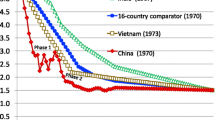Abstract
China's policy of one child per family was put in place in 1979 to control population growth in the world's most populous nation. Who complies with the policy, and why? What guidance does economic theory provide? Using microdata available from the 1985 Chinese In-Depth Fertility Survey, a multinomial logit model of family choice with respect to policy compliance is estimated. The results indicate that even after area of residence is taken into account, woman's education, husband's occupation, marriage duration, presence of a son, family structure, and house size significantly influence compliance, while age, child mortality experience, husband's education and woman's occupation apparently do not. The effects of income and wealth remain open questions. Possible explanations are provided.
Similar content being viewed by others
References
Amemiya T (1981) Qualitative response models: A survey. J Econ Liter 19 (4):1483–1536
Amemiya T (1985) Advanced econometrics. Harvard University Press, Cambridge
Arnold F, Liu Z (1986) Sex preference, fertility, and family planning in China. Popul Dev Rev 12 (2):221–246
Buse RC, Salathe LE (1978) Adult equivalent scales: An alternative approach. Am J Agric Econ 60 (3):460–468
Coale AJ (1984) Rapid Population Change in China 1952–1982. Committee on Population and Demography, Report No. 104. National Academy Press, Washington, DC
Croll E (1983) Chinese women since Mao. ME Sharpe, Armonk, NY
Croll E, Davin D, Kane P (1985) China's one child family policy. St. Martin's Press, New York
Falbo T (1989) China's one-child policy: Conflict and harmony. Paper presented at 19th Annual Meetings of the Population Association of America, Baltimore, Maryland
Gabriel SA, Rosenthal SS (1989) Household location and race: Estimates of a multinomial logit model. Rev Econ Statist 71 (2):240–249
Goldstein S (1990) Urbanization in China, 1982–1987: Effects of migration and reclassification. Popul Dev Rev 16 (4):673–701
Greene WH (1988) LIMDEP. Department of Economics, New York University
Greenhalgh S (1989) The evolution of the one-child policy in Shaanxi, 1979–1988. Paper presented at the 1989 Annual Meeting of the Association for Asian Studies, Washington, DC
Hardee-Cleaveland K, Banister J (1988) Fertility policy and implementation in China. Popul Dev Rev 14 (2):245–286
Hausman J, McFadden D (1984) Specification tests for the multinomial logit model. Econometrica 52 (5):1219–1240
Horowitz J (1983) Statistical comparison of non-nested probabilistic choice models. Transport Sci 17 (3):319–350
Larsen U (1990) An assessment of the one-child policy in China from 1980 to 1985. Eur J Popul 6 (3):257–284
Maddala GS (1983) Limited-dependent and qualitative variables in economics. Cambridge University Press, Cambridge
Manski C, McFadden D (1981) Structural analysis of discrete data. MIT Press, Cambridge
McFadden D (1974) Conditional logit analysis of qualitative choice behavior. In: Zarembka P (ed) Frontiers in econometrics. Academic Press, New York, pp 105–142
Population and Development Review (1988) Sichuan provincial birth planning rules 14 (2):369–375 (Documents)
Pudney S (1989) Modelling individual choice: The econometrics of Corners, Kinks and Holes. Basil Blackwell, Oxford New York
Schmidt P, Strauss RP (1975) The predictions of occupations using multiple logit models. Int Econ Rev 16 (2):471–486
Small KA, Hsiao C (1985) Multinomial logit specification tests. Int Econ Rev 26 (3):619–627
State Statistical Bureau of China, Department of Population Statistics (1986) China in-depth fertility survey (Phase-I). Principal Report, Vol I
Survey of the World Broadcasts (1979) Sichuan regulations in family planning. 16 march (FE 6068/1311/9)
Wang F (1988) The roles of individuals socioeconomic characteristics and the Government Family Planning Program in China's fertility decline. Popul Res Policy Rev 7 (3):255–276
Wang F (1989) China's one-child policy. Who complies and why? Paper presented at the Association for Asian Studies Meeting, March 17–19, Washington, DC
Zhang J (1990a) Two essays on the economics of marriage and fertility. Ph. D. Thesis, McMaster University, Hamilton
Zhang J (1990b) Socioeconomic determinants of fertility in China: A microeconomic analysis. J Popul Econ 3 (3):105–123
Author information
Authors and Affiliations
Additional information
The authors are grateful to Trevor Breusch, Martin Browning, Frank Denton, Jerry Hausman, Thomas Kniesner, Lonnie Magee, Michael McAleer, Chris Skeels, Yuk K. Tse, Frank Vella, seminar participants at Australian National, Macquarie, McMaster, and Trent Universities, and to two anonymous referees and John Ermisch for many helpful comments and suggestions. They thank the International Statistical Institute and the State Statistical Bureau of China for access to the 1985 In-Depth Fertility Survey.
Rights and permissions
About this article
Cite this article
Zhang, J., Spencer, B.G. Who signs China's one-child certificate, and why?. J Popul Econ 5, 203–215 (1992). https://doi.org/10.1007/BF00172093
Received:
Accepted:
Issue Date:
DOI: https://doi.org/10.1007/BF00172093




